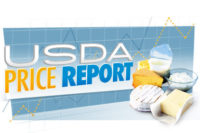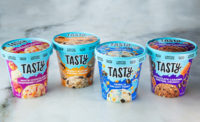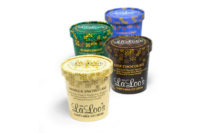
In the old days, hosting an ice cream social was a way to bring people together. In the 21st century, brands are using social media to introduce shoppers to ice cream and other dairy products. Call it the emergence of the ice cream social media. Dairy processors are turning to Facebook, Foursquare, Flickr, Twitter, YouTube and other outlets to engage consumers.
Stonyfield Farm used just about every social media and new media tool available to promote its organic yogurts and other dairy products at the 2010 US Open tennis championship. In addition to Facebook, Twitter, Foursquare and Flickr, the Londonderry, N.H.-based dairy processor incorporated product sampling and contests tied to the sporting event held at the USTA Billie Jean King National Tennis Center in Queens, New York. The two-week-long tournament ended Sept. 13.
Amy VanHaren, social media manager for Stonyfield Farm, said the company wanted to bring the excitement consumers have for its products to the online world. Stonyfield’s activities resulted in increased visits to the company’s website and Facebook page, mentions by bloggers and Twitter followers, and a “huge growth in engagement levels,” VanHaren said.
The company hired temporary workers to tweet daily from the tennis complex, upload pictures to a photo-sharing site and engage visitors about their favorite yogurt brands. A contest on the company’s website asked visitors to vote for one of two flavors; the pairs changed daily. Voters were eligible to win a daily prize (a week’s supply of yogurt) and a grand prize (a year’s supply). The contest drew 35,000 visitors to the website and Stonyfield captured 6,000 opt-in email addresses, VanHaren said. King Design of Philadelphia created the voting site.
“People like to interact,” VanHaren said, and the numbers back her up. The social media activities increased the company’s Facebook followers threefold and Facebook page views by 200%. “We gave them an outlet to engage,” she said.
Like last year, Stonyfield Farm had a sampling program. It distributed tens of thousands of free samples of Oikos Organic Greek yogurt, YoKids Squeezers and B-Well and B-Healthy organic yogurts with B vitamins. This year it also sponsored the Stonyfield Café, which sold some of the company’s yogurt products as well as fresh salads, flatbread sandwiches, soups and organic Honest Tea beverages.
“Our mission promoting healthy food, healthy people, a healthy planet and healthy business makes this unique partnership with the US Open a great match,” said Stonyfield president Gary Hirshberg who also holds the title of CE-Yo. “While watching tennis matches between some of the most fit athletes in the world, it only seems logical to have healthy, fresh, natural and organic offerings available to fans,” he said.
A weekly dose of humor draws moms to the website of Kraft Foods, Northfield, Ill. Kraft commissioned comedian Anita Renfroe to create a series of 90-second to two-minute videos in which she jokes about breathing class, raising children, chocolate, cool moms and other subjects. A logo of a Kraft brand appears at the start and end of each segment, but Renfroe doesn’t talk about Kraft products (except for Kool-Aid in the cool moms bit). A new video is posted every Monday at www.yougottalol.com. The segments were produced and directed by Meredith Integrated Marketing, a division of media giant Meredith Corp., Des Moines, Iowa.
Guerilla marketing activities can create word-of-mouth buzz through the online world and gain free publicity in newspapers and on television. In September, Cabot Creamery Cooperative, Montpelier, Vt., participated in an effort in New Orleans to create the world’s largest serving of macaroni and cheese. The stunt raised $21,000 for New Orleans Area Habitat For Humanity and supported the city’s Magnolia School and the Second Harvest Food Bank of Greater New Orleans. The 2,469-pound serving, cooked up by chef John Folse & Co. (the parent company of several food-related industries), broke the previous Guinness world record of 414 pounds. Guests paid $5 for an “all-you-can-eat” bowl of the pasta dish.
Organic Valley, La Farge, Wis., took to the road in October with a two-week “Who’s Your Farmer?” tour. Young farmers, dubbed by the company “Generation Organic,” piloted a biofueled bus from Wisconsin to Washington, D.C. The tour stopped at college campuses, including Oberlin, Bennington, Harvard and Yale. In Washington, the young farmers, age 18 to 35, talked with senators and representatives. The group documented the tour on a Facebook page (www.facebook.com/GenerationOrganic) with photos and links to news media coverage.
As the use of social media by dairy food processors continues to heat up, brands will seek new ways to be cool.
- Jim Carper, Chief Editor
Food, Beverage Industry Releases Front-of-Pack Nutrition Labeling Initiative
America’s leading food and beverage manufacturers and retailers joined forces in the fight against obesity and announced their commitment to develop a new front-of-package nutrition-labeling system. This program will encourage processors to add important nutrition information on calories and other nutrients to the front of the packages of many food and beverage products. To appeal to on-the-go consumers, the information will be presented in a fact-based, simple and easy-to-use format.
In the coming months, the Grocery Manufacturers Association (GMA) and the Food Marketing Institute (FMI) will finalize the details of the initiative, including the technical and design elements. In addition, details will be finalized on how to provide consumers with information on nutrients needed to build a “nutrient-dense” diet and on “shortfall nutrients” that are under-consumed in the diets of most Americans.
“The food and beverage industry is committed to empowering consumers by providing them with the products, tools and information they need to achieve and maintain a healthy diet,” said Pamela G. Bailey, president and CEO of GMA, Washington, D.C. “This initiative comes on top of the 20,000 healthier product choices we have developed, the responsible marketing practices we have adopted and the tens of millions of dollars we spend annually on healthy lifestyle promotion.”
Consumers will begin to see the new label in the marketplace early next year. “Thanks to this initiative and many other innovative industry programs, consumers will now have access to more information about their food than ever before,” said Leslie G. Sarasin, president and CEO of FMI, based in Arlington, Va. “This unprecedented partnership with manufacturers will expand access to nutrition information for all Americans and give shoppers a powerful tool to assist them in selecting nutritious products.”
To build consumer awareness and promote use of the new label, America’s food and beverage manufacturers and retailers have agreed to support the change to their product labels with a $50 million consumer education campaign. The campaign, to be launched in 2011, is aimed at parents who are primary household shoppers.
“Through this initiative, we continue to deliver on our promise to our consumers and demonstrate that we are moving farther, faster in our ongoing effort to play a constructive and responsible role in the fight against obesity,” Bailey said.
IDFA Urges Trade Negotiations Between U.S., South Korea
The International Dairy Foods Association urges continued negotiations between the United States and South Korea to reach agreement on an expansive free-trade agreement with South Korea. President Obama and South Korean President Lee Myung-bak announced in November that after intense negotiations leading up the Group of 20 Summit, more negotiations were needed before a deal could be reached.
IDFA considers this agreement critical for the U.S. dairy industry to take full advantage of growing markets in a vital economic region. The agreement is expected to provide reduced tariffs and expanded market opportunities in a very restricted and high-value market that received $76 million in U.S. dairy exports in 2009. South Korea is the United States’ sixth largest export market for dairy and dairy products.
“It is imperative that the agreement be ratified quickly for its benefits to be fully realized,” says Clay Hough, senior group vice president and general counsel for IDFA, based in Washington, D.C. “The U.S. dairy industry will gain immediate open access for whey for feed uses, as well as tariff-free access for approximately 16,000 metric tons of cheese, milk powders, whey for food uses and other important dairy products.”
IDFA strongly encourages quick action to complete negotiations and implement the agreement, and notes that Korea is in the process of finalizing a competing agreement with the European Union.
South Korea is one of Asia’s fastest growing economies. Global consumption patterns show that the consumption of animal protein, including dairy, increases as income grows. Per capita consumption of dairy products in South Korea is increasing mainly due to the younger generation and its penchant for Western foods such as pizzas, cheeseburgers and sandwiches.
The continuing growth in fast food and the rapid growth of wine consumption are also expected to increase demand for a variety of high-quality cheeses. According to the U.S. Department of Agriculture, most of this increased demand will be supplied by imports because local production of cheese is constrained by the lack of manufacturing facilities. U.S. dairy exports are positioned to fill a specific consumer demand, which local manufacturers are not able to supply.
Through August, the value of U.S. dairy exports to South Korea was $84 million, up 78% from the same time period last year. The U.S. International Trade Commission estimated that the dairy provisions of the agreement would expand U.S. dairy exports by $175 million to $336 million.
Once an agreement is reached between the two nations, Congress will need to ratify it.




